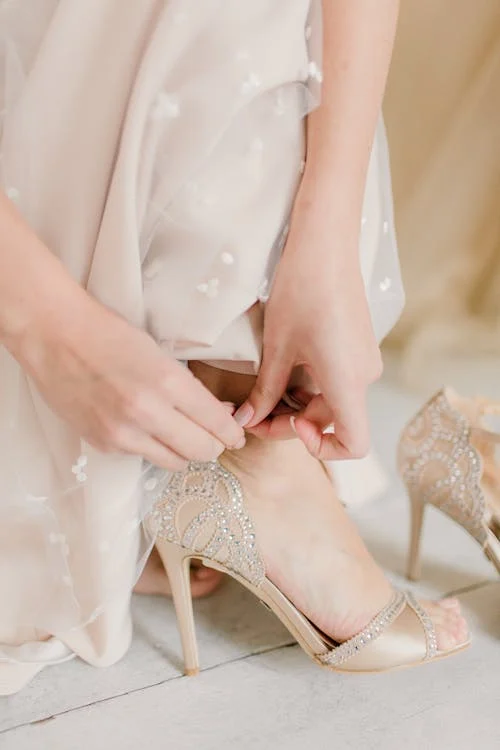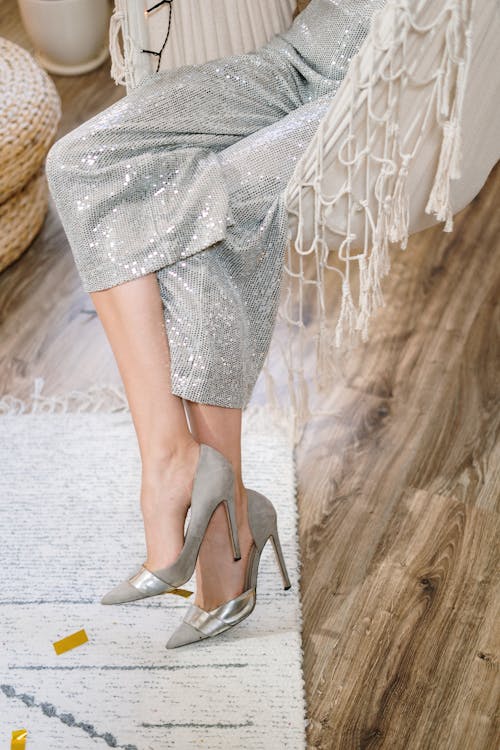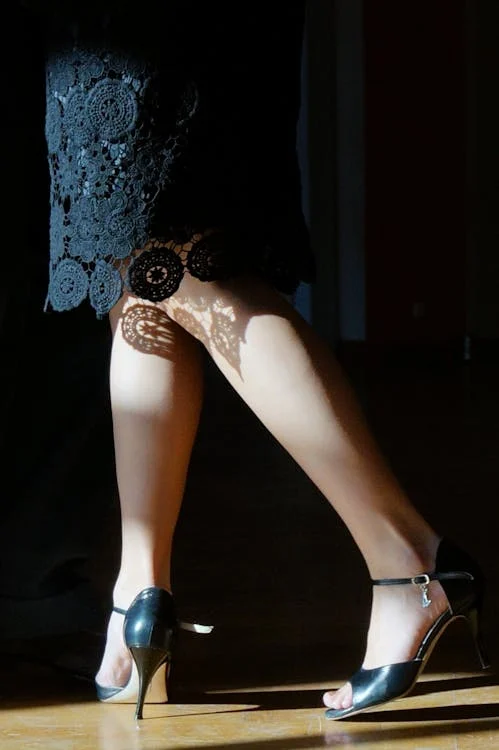Introduction:
In the world of fashion, high heels have long been synonymous with elegance, power, and style. However, beneath their alluring facade lies a hidden discomfort that many women can relate to — the pain of wearing high heels. Why do high heels hurt? This blog delves into the science behind the pain, exploring the anatomy of high heels and foot mechanics. . Discover the truth behind the pain and learn how to make informed footwear choices without compromising style.
The Anatomy of High Heels and Foot Mechanics
The Height and Angle: Impact on Body Alignment and Weight Distribution
The height and angle of high heels play a significant role in how they affect our body alignment and weight distribution. Here’s how:
Altered Center of Gravity:
High heels shift the body’s center of gravity forward, causing an imbalance that affects the alignment of the spine.
Increased Pressure on the Forefoot:
The angle of high heels places more weight on the ball of the foot, leading to excessive stress on the metatarsophalangeal joints.
Pressure Points: Areas of High Stress and Discomfort
Wearing high heels can create specific pressure points on the feet, causing discomfort and pain. Consider the following factors:
Forefoot Area:
The front of the foot bears the brunt of the pressure in high heels, leading to conditions like metatarsalgia and bunions.
Heel and Achilles Tendon:
The elevated position of the heel in high heels can strain the Achilles tendon and cause discomfort in the back of the foot.
Understanding the anatomy of high heels and their impact on foot mechanics allows us to comprehend why wearing them can often result in discomfort. The height and angle of high heels alter body alignment and weight distribution, while pressure points on the forefoot and heel area contribute to pain and stress.

Biomechanical Factors Behind High Heel Pain
We will explore the biomechanical factors that contribute to high heel pain and why wearing them can cause discomfort and even long-term issues.
Increased Pressure on the Forefoot: Metatarsalgia and Other Conditions
Wearing high heels increases pressure on the forefoot, leading to various conditions and discomfort. Consider the following:
Metatarsalgia:
The heightened pressure on the metatarsal heads can cause inflammation and pain in the ball of the foot.
Neuromas:
The compression and aggravation of nerves between the metatarsal heads can result in conditions like Morton’s neuroma.
Limited Foot Movement: Impact on Natural Gait and Muscles
The restricted foot movement caused by high heels affects the natural gait and muscles in the feet. Here’s how:
Shortened Achilles Tendon:
Wearing high heels causes the Achilles tendon to remain in a shortened position, resulting in tightness and potential strain.
Weakened Ankle and Calf Muscles:
Constant elevation of the heel in high heels can lead to muscle imbalances, weakening the ankle and calf muscles.
Altered Posture and Spine Alignment: Effects on the Lower Back
High heels profoundly impact posture and spine alignment, particularly in the lower back area. Consider the following:
Increased Lumbar Lordosis:
High heels tilt the pelvis forward, increasing the curvature of the lower back and potentially causing discomfort.
Strain on the Spine:
Altered posture due to high heels can cause strain on the spine, leading to lower back pain and potential long-term issues.
Understanding the biomechanical factors behind high heel pain sheds light on why wearing them can be uncomfortable and even detrimental to foot health. The increased pressure on the forefoot, limited foot movement, and altered posture and spine alignment all contribute to pain and potential long-term issues.

Pressure Relief and Prevention Strategies
High heels may cause discomfort, but there are strategies to relieve and prevent pain.
Choosing the Right Fit: Shoe Size, Width, and Arch Support
Selecting high heels that offer the right fit is essential for reducing pressure and discomfort. Consider the following factors:
Accurate Shoe Size:
Ensure the high heels fit properly by getting your feet measured to avoid tightness or pinching.
Appropriate Width:
Choose high heels that match your foot width to prevent compression and promote better weight distribution.
Adequate Arch Support:
Opt for shoes that provide proper arch support to maintain foot stability and reduce strain.
Cushioning and Shock Absorption: Importance of Insoles and Padding
Enhancing cushioning and shock absorption in high heels can significantly alleviate pressure. Here’s how:
Arch Support Inserts:
Consider using arch support inserts or orthotics to provide additional cushioning and reduce strain on the arches.
Gel Pads and Cushions:
Place gel pads or cushions in high-pressure areas such as the ball of the foot or the heel to minimize discomfort.
Gradual Adaptation: Building up Tolerance and Strengthening the Feet
Gradually adapting to high heels and strengthening the feet can increase comfort and reduce pain. Consider the following techniques:
Start with Lower Heights:
Begin with lower heel heights and gradually work your way up to allow your feet to adjust and build tolerance.
Foot Strengthening Exercises:
Perform targeted exercises, such as toe curls and calf stretches, to strengthen the muscles that support your feet.
Regular Breaks:
Take regular breaks from wearing high heels to give your feet a chance to rest and recover.
While high heels may cause discomfort, there are effective relief and prevention strategies to alleviate the pressure. By choosing the right fit, incorporating cushioning and shock absorption, and gradually adapting and strengthening your feet, you can enjoy the style of high heels without sacrificing foot comfort.

Occasional vs. Prolonged High Heel Use
Special Occasions and Temporary Discomfort
Wearing high heels for special occasions may seem like a glamorous choice, but it often comes with temporary discomfort. While some individuals can handle short periods of discomfort, others may find it challenging to withstand the strain it puts on their feet. Understanding the distinction between occasional and prolonged high heel use is crucial to make informed decisions about footwear.
Brief High Heel Use and its Effects
Short-term high heel use, such as for events or parties, can lead to temporary discomfort. The pressure on the balls of the feet and the unnatural foot position might cause pain, blisters, and soreness. However, the effects are typically short-lived, as our bodies are resilient enough to recover from occasional use. Taking breaks, utilizing proper padding, and choosing well-fitted shoes can alleviate some of the discomfort associated with brief high heel use.
The Dangers of Prolonged High Heel Use
In contrast, prolonged high heel use can have more severe consequences for foot health. Wearing high heels for extended periods puts constant pressure on specific areas of the foot, leading to potential foot deformities and chronic pain. Conditions like bunions, hammertoes, and metatarsalgia may develop over time, causing discomfort that can persist beyond the immediate wearing of high heels.
Foot Deformities and their Impact
Continuously subjecting our feet to the constraints of high heels can result in permanent foot deformities. Bunions, characterized by a bony protrusion at the base of the big toe, can be painful and may require medical intervention to correct. Additionally, the repeated pressure on the toes can cause hammertoes, where the joints become permanently bent. These deformities not only cause physical discomfort but can also affect the aesthetics and functionality of the feet.
Chronic Pain and its Ramifications
Prolonged high heel use can lead to chronic pain that persists even when the heels are not worn. The strain on the foot arches, balls of the feet, and Achilles tendons can cause conditions like plantar fasciitis and Achilles tendonitis. These conditions result in pain, inflammation, and difficulty performing everyday activities. Ignoring the signs of chronic pain can exacerbate the condition and lead to long-term consequences.
While occasional high heel use may result in temporary discomfort, prolonged use can have more significant consequences. Foot deformities, chronic pain, and long-lasting discomfort are potential outcomes of continuously subjecting our feet to high heels.

Alternatives to Traditional High Heels
Lower Heel Heights: Finding a Balance between Style and Comfort
For those seeking a compromise between style and comfort, lower heel heights provide an excellent alternative to traditional high heels. With heels ranging from one to three inches, these shoes offer a stylish lift without putting excessive strain on the feet. Lower heel heights distribute weight more evenly, reducing the discomfort often associated with higher heels. They are a practical choice for those wanting to maintain a fashionable look while prioritizing foot comfort.
Wedges and Platform Heels: Enhanced Stability and Support
Wedges and platform heels are an excellent option for those seeking enhanced stability and support. Unlike traditional high heels, these designs feature a wider base that provides a broader contact area with the ground, offering improved balance. Additionally, the platform or wedge structure helps distribute the weight across the entire foot, reducing the pressure on specific areas. This innovative design allows individuals to enjoy the height and style of heels while minimizing discomfort and maintaining a steady stride.
Innovative Footwear Designs: Incorporating Technology for Pain Relief
Advancements in footwear technology have led to innovative designs aimed at providing pain relief and improving overall foot comfort. Footwear brands now incorporate features like cushioned insoles, arch support, and shock absorption materials into their shoe designs. These technological advancements help alleviate discomfort by reducing the impact on the feet and providing additional support. With these innovative options available, individuals can enjoy the aesthetic appeal of heels while prioritizing their foot health.
Alternative options to traditional high heels provide individuals with the opportunity to prioritize both style and foot comfort. Lower heel heights offer a balance between fashion and comfort, while wedges and platform heels provide enhanced stability and support. Innovative footwear designs with advanced technologies help alleviate pain associated with high heels.
Conclusion:
In conclusion, the pain experienced while wearing high heels is not merely a result of fashion sacrifice but is deeply rooted in the intricate science of foot mechanics. Understanding the anatomy of high heels, the biomechanical factors at play, and the pressure relief and prevention strategies can empower individuals to make conscious decisions about their footwear. Whether opting for occasional or prolonged high heel use, or exploring alternatives to traditional high heels, prioritizing foot health and comfort should always be at the forefront. So the next time you slip into those glamorous high heels, you can do so with a greater awareness of the science behind the pain and the options available to alleviate it.
